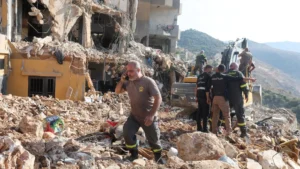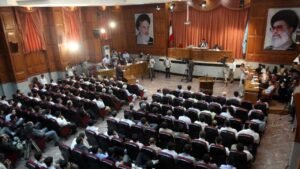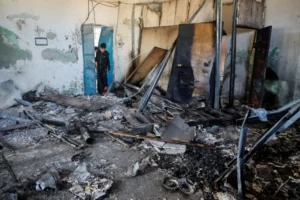Political crisis in Ethiopia and the risks of ripple effect humanitarian crisis in the Horn of Africa
By:Nick Ogutu
Refugee and Immigrant Rights Activist, Executive Director of Columbia University based Initiative, Safari Yangu Immigrant Stories, President, Amnesty International Bronx New York. The views expressed in this commentary are his own.
Ethiopia, with more than 100 million people, is the second most populous country in Africa after Nigeria. It hosts the headquarters of the African Union and its geographical location makes it a strategic resource for the Western powers in their counterterrorism efforts. Ethiopia maintains very strong support from foreign donors despite its deteriorating human rights record (New York Times, 2016).
Ethiopia is currently under a state of emergency due to recent protests and violence. This violence has caused widespread internal displacement. In addition to its own internal turmoil, Ethiopia plays a crucial role in the region as a host of refugees itself. According to United Nations High Commissioner for Refugees (UNHCR, 2018), “Ethiopia is host to the second largest refugee population in Africa, with over 847,200 refugees from nineteen countries, the majority originating from neighboring South Sudan, Somalia, Eritrea, and Sudan”. The political crisis in Ethiopia cannot, therefore, be told in isolation. Ethiopia is part of the Horn of Africa, the easternmost extension of African land, comprised of the countries mentioned above, and Kenya. These countries share a long history and many diverse communities live across the region. Due to political instability, the region has seen many conflicts and is very fragile. This article will examine the complex relationships between Ethiopia and its neighbors in order to understand the risks of a multi-country humanitarian and refugee crisis in the Horn of Africa.
The Ethiopia and Eritrea Conflict
Following many years of conflict between Ethiopia and Eritrea and at some point, involving Italy as well, Eritrea was formally recognized as an independent country after the 1993 referendum. Eritrea believes that Ethiopia is constructed of different nationalities that were forced together during the imperial scrambles for Africa, and is therefore held together with weak, artificial alliances. Therefore, the Eritrean opposition’s approach has been to conduct sharp, well directed military offenses in the hopes that Ethiopia will collapse. Hence, they identified south-eastern Ethiopia, inhibited by Ethiopians of Somali origin, as the weakest point of Ethiopia. For more than 30 years, escalation of conflict has continued along borders killing many people, displacing many people from their homes and adding to the regional refugee crisis (Axel Borchgrevink & Jon Harald Sande Lie, 2009).
The hostility between these countries has adversely affected the Somali communities that live along the common border between Ethiopia and Eritrea. According to a Human Rights Watch report (2018), the Somali region security forces’ intolerance for dissent by the Somali community extends beyond the border into Eritrean territory, targeting families with relatives across the border. Hundreds of thousands of people have been internally displaced since.

Ethiopia’s Long Border with Somalia & The Somali Diaspora
Somalia has almost one million citizens living in the diaspora, many of which are refugees and asylum seekers. Any conflict in Ethiopia would result in a grave situation in Somalia, given the long, unmarked border that Ethiopia and Somalia share. In fact, Ethiopian military has in the past crossed its southeastern border and intervened inside Somalia (New York Times, 2011)
Somalia is one of the most unstable countries in the region at the moment. Since the former president Mohamed Siad Barre was overthrown in a bloody civil war in 1991, Somalia has not had a stable government. Parts of the country have either seceded or are run by different warlords. Some militant groups like the Union of Islamic courts, which later evolved into the now infamous Al-Shabaab, have been labeled as terrorist organizations.
More than 10 peace conferences were held throughout the 1990s to address the sources of conflict and possibilities for peace in Somalia, but they were largely unsuccessful. (Axel Borchgrevink & Jon Harald Sande Lie, 2009). Since then, other efforts followed, and Somalia is now governed under the Federal Government of Somalia, a government which is not widely accepted and has faced constant opposition and threats from different militant groups. The fragile government is protected by the African peacekeeping forces, AMISOM (African Union Mission in Somalia).
Ethiopia’s southern Kenya Border & Regional Refugee Hosting Challenges
Kenya is one of the most stable countries in the region, with a diverse economy and vibrant democracy, civil society, and press. However, Kenya has faced its own human rights challenges. Just like Somalia, Kenya shares common ethnic and geographical similarities with Ethiopia. The upper eastern province of Kenya is predominantly Oromo and Somali ethnic populations, ethnic groups that also reside in Ethiopia and Somalia. Apart from the recently arrived refugees, many of the Oromo and Somali ethnic populations have lived in Kenyan for decades and are Kenyan citizens.
The Kenyan government has long supported the Ethiopian government, showing a blind eye to the human rights violations it is accused of. Ethiopian refugees face so many challenges in Kenya. It takes months if not years to get official recognition as a refugee, a status you need to access any benefits from the host government or UNHCR (United National High Commission for Refugees). Kenya has an encampment policy, which requires refugees to stay in the camps at Dadaab and Kakuma. These camps presently also house refugees from Sudan and Somalia. The two camps are the biggest in the world and cannot accommodate any more refugees. Refugees in Kenya who choose to not stay in the camps faces arrest and prosecution by the Kenyan authorities. Amnesty International Annual report (2018), explains how the Ethiopian government has taken advantage of that loop-hole in Kenya refugee policy to harass their own citizens in Kenya. The Ethiopian Embassy in Nairobi has recruited spies and bribed the Kenyan police to target the Oromo refugees in Nairobi and other cities (Human Rights Watch, 2018). Many of these refugees have been either killed, tortured, or deported back to Ethiopia.
Kenya has gone through its own internal economic and social challenges that have had negative effects on the refugee populations it hosts. The economy is shrinking, and the country is divided along tribal and regional lines due to political upheavals. For a number of years, Kenya has threatened to close down the refugee camps (UNHCR, 2015) and repatriate the refugees back to their countries of origin, citing security fears and the economic burden. Kakuma and Dadaab refugee camps remain open only due to a court order and international pressure. UNHCR (2017) while urging the government to reconsider their decision, issued this statement, “UNHCR works closely with the Government of Kenya and we understand well the current regional security situation and the seriousness of the threats Kenya is facing. We also recognize the obligation of the government to ensure the security of its citizens and other people living in Kenya, including refugees.” Kenya is concerned about terror groups using refugee camps as recruitment centers, especially after the Garissa university terror attack (Kenya Daily Nation, 2017). The terror suspects were found to be operating from the Dadaab refugee camp.
Current Ethiopian Political Concerns
If the Ethiopian crisis escalates, it could spiral into a regional catastrophe affecting more than six countries. When the former Ethiopian Prime Minister Hailemariam Desalegn announced his draft of reforms that included the release of thousands of political prisoners (Human Rights Watch, 2018), there was a sense of relief among civil society and the international community that finally the government was serious about addressing some of its political issues. However, his resignation weeks later shocked many, and the subsequent declaration of a state of emergency (Reuters, 2018). Some of the recently released prisoners have since been re-arrested (Amnesty International, 2018) and then released on bail, and many people live in fear.
Since the state of emergency was declared in Ethiopia, almost one million Ethiopians have been internally displaced, and thousands have crossed the border into Kenya. Activists have also sounded the alarm on the rising incidences of rape and other gender-based violence, allegedly committed by the police and the military (Amnesty International, 2018). Last month’s election of the new Prime Minister, Abiy Ahmed, a former lieutenant-colonel in the army and the first Prime Minister from the Oromo community, has not definitely quelled any fears from the general public.
The Ethiopian situation is a time-bomb that the international community must take an active role in to ensure stability. With a population of over 100 million, the current refugee crisis in the Horn of Africa risks meeting the levels of the humanitarian crisis in Syria, Iraq, and the Congo. With so much instability in the region, including the ongoing war in South Sudan, most of the countries neighboring Ethiopia are terrified.
There has been evidence of victims of slavery and human trafficking in Libya are refugees from the horn of Africa (The East African, 2018). Any further escalation of violence Ethiopia and instability in the region will push more refugees to attempt the already dangerous journey to Europe through North Africa and the Mediterranean Sea.
Reforms Required: A Call to Action
The political opposition, civil society, and the press must be given a respected space and a voice in Ethiopian society to ensure transparent governance. The Ethiopian democratic space must be opened and widened as the political landscape is quickly shifting. It will have to accommodate the people’s demands, especially the most vulnerable such as displaced populations, if the current ruling party wants to govern equitably.
As a key western ally receiving billions of dollars from the U.S., U.K., Germany, Italy, the Netherlands and Canada, the West must use that leverage for reforms before instability in Ethiopia have widespread repercussions across the region. All political prisoners should be released, responsive and representative government formed, end state of emergency, compensate victims of violence and perpetrators of crime to face justice. Without these urgent reforms, unrest in the country could have a domino effect in what is an already volatile part of the African continent.





